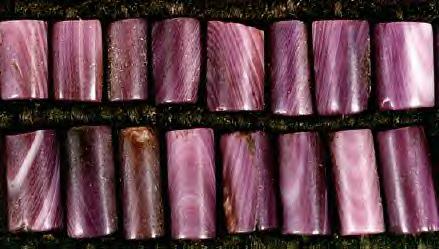|
|
Canku Ota |
|
|
(Many Paths) |
||
|
An Online Newsletter Celebrating Native America |
||
|
april 21, 2001 - Issue 34 |
||
|
|
||
|
Oneida Nation's History Uncovered |
||
|
by Michelle Breidenbach Syracuse Online |
||
|
Wampum photo from the Shako:wi Cultural Center |
 Dig by Colgate
students and teens from the nation turns up 17th century artifacts. Dig by Colgate
students and teens from the nation turns up 17th century artifacts.Presented alone, each item found in a Stockbridge forest is a tiny piece of evidence to ponder. A glass bead. A clay pipe. A Dutch coin. A corn kernel. A Jesuit ring. Laid out on the same table, the artifacts tell the story of an Oneida Indian village 350 years ago. In 1650, Oneida Indian people probably shared two long houses on a hill overlooking the Stockbridge Valley and, in the distance, Oneida Lake. They may have picked the highest spot in order to defend their people from other Iroquois nations, Colgate University archaeologist Jordan Kerber reasoned. The people probably grew maize, pounded stone into tools and flattened copper and brass pots to make triangular projectile points for hunting. They traded their goods with Europeans for glass beads, a clay pipe and a musket. After 10 or 15 years, they probably moved on, Kerber said. Kerber spoke Thursday morning at the Oneida Indian Nation's Shako:wi Cultural Center about evidence found the past three years in a Stockbridge forest. He showed slides of some of the 3,000 artifacts uncovered by Colgate students and teen-age members of the Oneida Indian Nation. He brought some of the pieces for people to see and touch. The group has searched for three years on land scoured by amateur archaeologists in the 1970s. That group uncovered the foundations of two long houses, but Kerber's group has not yet found the posts. Instead, Kerber's students have spent their time sifting soil in a spot that may have been a trash pit. They dug test sites about 50 centimeters wide and 50 centimeters long and 10 inches deep. They poured the soil through a stack of 1/8-inch and ¼-inch mesh screens to separate the dirt from the treasures. Because the area has been plowed, some artifacts are lying on the surface of the soil, he said. "The students train their eyes so they know what to look for," Kerber said. "It's a little bit of a daunting task to say, 'OK, go look for some artifacts.' " They have uncovered several glass trade beads, gun parts, bone remains and metal points. "People are very enthusiastic when they find something," he said. "They make a connection to history, touching something your ancestors used or wore centuries ago." Members of the Oneida Indian Nation who attended Kerber's lecture agreed with his observation. Physical evidence of ancient Oneida people lends credibility to stories passed down through generations, said Clint Hill, a member of the nation's Men's Council. "We have our stories. We have our legends," Hill said. "We have nothing physical to go with our stories and legends. We know we've been here for thousands of years, but to know there was a long houses goes along with our stories. They're not myths." Non-Indian landowners also attended Thursday's presentation to verify the artifacts they've uncovered in their fields and forests over the years. Al Sterling said he found projectile points, net weights and tools when he was a child living along Oneida Creek. "When I was a little, little kid, my Dad would come in and would reach in his shirt pocket and pull out a bead or something else he found while he was plowing and disking," Sterling said. "We have such a rich and unique history in New York." Birdy Burdick, program coordinator for the Shako:wi, said she will put some artifacts on public display at the cultural center, on Route 46. For dates and times, call 363-1424. "To see anything associated with my ancestors helps touch down with my history," Burdick said. "Whatever happened there is what made us what we are today." |
|
Shako:wi Cultural Center |
|
|
||
|
|
||
| Canku Ota is a free Newsletter celebrating Native America, its traditions and accomplishments . We do not provide subscriber or visitor names to anyone. Some articles presented in Canku Ota may contain copyright material. We have received appropriate permissions for republishing any articles. Material appearing here is distributed without profit or monetary gain to those who have expressed an interest. This is in accordance with Title 17 U.S.C. section 107. | ||
|
Canku Ota is a copyright © 2000, 2001 of Vicki Lockard and Paul Barry. |
||
|
|
|
|
|
The "Canku Ota - A Newsletter Celebrating Native America" web site and its design is the |
||
|
Copyright © 1999, 2000, 2001 of Paul C. Barry. |
||
|
All Rights Reserved. |
